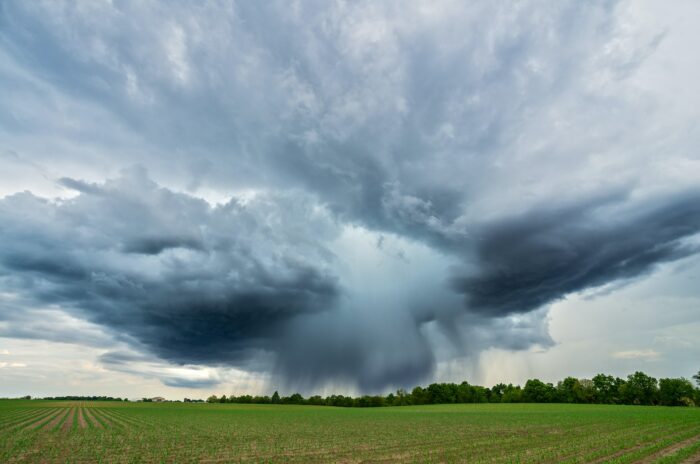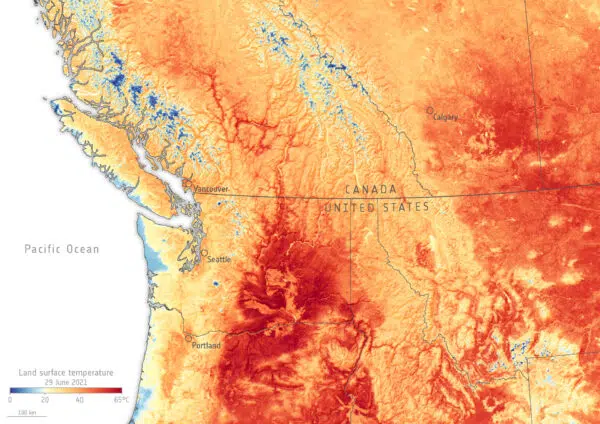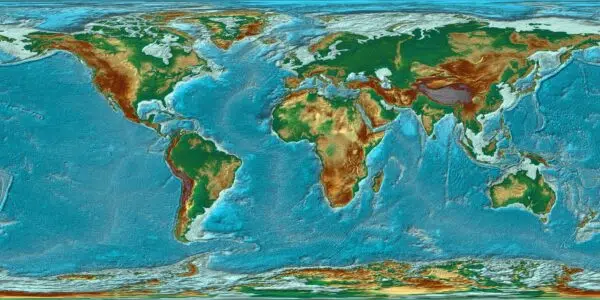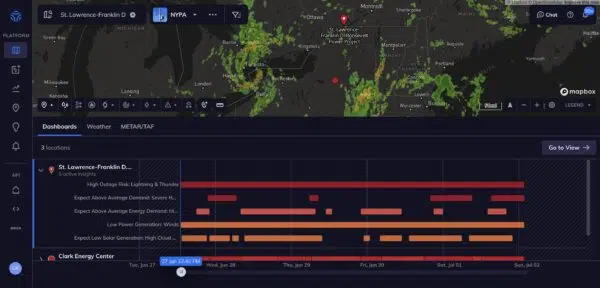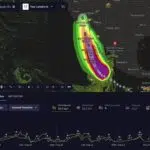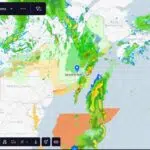Are you prepared for the next high-impact weather event?
When nature unleashes its fury in the form of severe and hazardous weather, it’s essential to understand its triggers, potential consequences, and know the best practices in preparedness.
High impact weather, which includes sudden storms, floods, heatwaves, and other extreme weather conditions, can greatly affect our day-to-day lives. Weather plays a critical role in our lives, affecting everything from our daily commutes to long-term business planning.
In this comprehensive guide, you’ll learn about high-impact meteorology phenomena and crucial information that could help protect your life and property from devastating effects.
What Is High-Impact Weather?
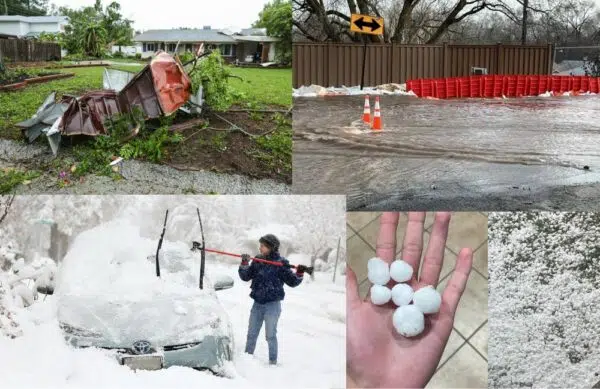
High impact weather refers to extreme meteorological events which have the potential to cause widespread disruption or damage. These occurrences can significantly affect our lives on multiple levels — from personal safety concerns to economic burdens. It is essential to recognize that these phenomena are not merely isolated incidents but an integral part of Earth’s highly intricate atmospheric system.
Some common features associated with high impact weather include:
- Intense precipitation leading to floods
- Dangerous lightning strikes during thunderstorms
- Damaging winds exceeding 50 miles per hour (80 kilometers per hour)
- Persistent heat waves causing various health hazards
- Severe cold spells resulting in ice storms or freezing rain
Understanding and accurately predicting high impact weather is essential for various sectors. For example, airlines need accurate forecasts to manage flight schedules and avoid dangerous conditions. Construction companies need reliable weather data to plan operations and ensure the safety of their workers. Governments and emergency services need precise and timely information to prepare and respond to potential disasters.
Each type of high impact weather event comes with unique risks and challenges. By understanding their causes and mechanisms, we will be better equipped to predict their future occurrence accurately, implement effective prevention measures when possible, or devise strategies for mitigating their impacts when they inevitably occur.
Types of High Impact Weather
High impact weather events can wreak havoc on communities and economies. In 2023 alone, we have seen numerous high impact weather events that have brought intense cold, severe snow, and now turbulent precipitation in much of the United States.
Understanding the various types of severe weather is crucial in predicting, preparing for, and mitigating potential damages. In this section, we will explore six common types of high impact weather: thunderstorms, tropical cyclones, hailstorms, floods, heat waves, and cold spells.
Thunderstorms
Thunderstorms are a type of weather phenomenon characterized by the presence of lightning and its acoustic counterpart – thunder. They typically develop in regions with warm, moist air that rises rapidly in an unstable environment.
The main factors contributing to their formation include atmospheric instability, abundant moisture, and a lifting mechanism (such as a cold front or rising terrain).
Thunderstorms have the potential to produce heavy precipitation rates leading to flash flooding and may also generate severe weather conditions such as:
- Strong wind gusts
- Hail
- Tornados
These hazards can cause significant damage to property and infrastructure while posing threats to human safety.
Tropical Cyclones
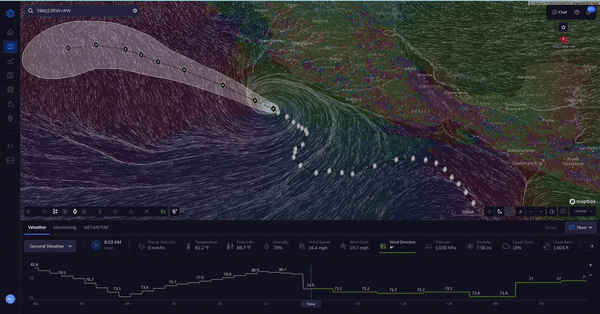
Tropical cyclones – commonly known as hurricanes or typhoons depending on location – are large-scale low-pressure systems that form over warm ocean waters. These storms are characterized by intense winds circulating around a central “eye” which contains relatively calm conditions in comparison. Tropical cyclones can produce extreme weather through various impacts including:
- Torrential rainfall resulting in widespread flooding
- Damaging storm surges along coastal areas
- Destructive winds causing widespread damage to structures
Preparedness for tropical cyclones is especially vital due to their propensity for causing loss of life and extraordinary amounts of economic damage.
Hailstorms

Hailstorms occur when powerful updrafts within thunderstorms lift raindrops into freezing layers of the atmosphere. This process results in ice spheres growing larger through accretion until they ultimately become too heavy for the updrafts to support and fall to the ground. Hailstones can range from small pea-sized pellets to destructive baseball-sized or even larger projectiles, which can cause significant damage to crops, vehicles, buildings, and other infrastructure.
Floods
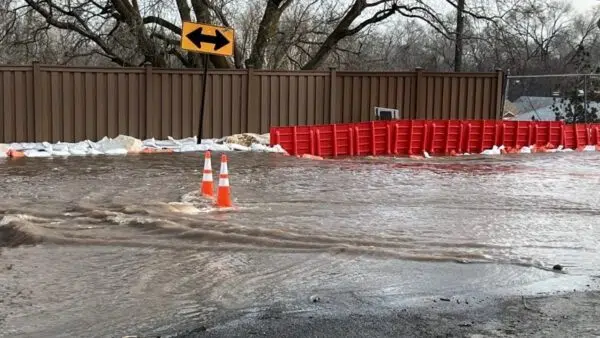
Floods are an often-underestimated type of high impact weather capable of causing immense devastation and human suffering. They occur when a substantial volume of water overflows onto typically dry land due to heavy rainfall or rapid snowmelt. Flooding may also result from the obstruction or failure of drainage systems and water control structures. Some common consequences of flooding include:
- Loss of life via drowning or injury
- Displacement of communities leading to strained resources
- Agricultural losses due to damaged crops and soils
- Substantial property damage including structural failures
Heat Waves
Heat waves are defined as prolonged periods of excessively hot weather caused by prolonged high-pressure systems that stagnate warm air masses. With increasing global temperatures due to climate change, heat waves have become both more frequent and severe. Heat waves pose significant risks to human health – particularly for vulnerable populations such as the elderly and those with pre-existing medical conditions – with hazards including dehydration, heat stroke, respiratory issues, and potential fatalities.
Cold Spells

Opposite in nature but equally impactful, cold spells refer to extended durations of unusually low temperatures caused by large-scale atmospheric patterns transporting frigid polar air toward lower latitudes.
Such events frequently generate hazardous meteorological phenomena like blizzards, ice storms, black ice formation on roads, and frostbite risk on exposed skin in outdoor activities during extremely cold weather warnings; all these factors contribute heavily to the need to prepare for winter storms and severe snow and cold.
The National Weather Service reported 15 high impact snow storms in the winter of 2023, and will likely be reporting more in late fall and early winter 2024.
What Contributes to High Impact Weather?
Causes of High Impact Weather
Understanding the factors that contribute to high impact weather is crucial for predicting and preparing for these extreme events. In this section, we will discuss climate change, geography and topography, and air pressure and wind patterns as primary factors contributing to severe weather conditions.
Climate Change
Climate change is undeniably one of the most significant drivers of high impact weather. As global temperatures continue to rise due to human activities, such as burning fossil fuels and deforestation, the Earth’s atmosphere becomes more unstable. According to NOAA, global temperatures rose about 1.98°F (1.1°C) from 1901 to 2020, but climate change refers to more than an increase in temperature. This instability and warming increase the likelihood of severe weather conditions occurring.
Some ways climate change contributes to high-impact weather events are:
- Warmer temperatures lead to higher evaporation rates, which can cause droughts in some areas while increasing atmospheric moisture levels in others.
- Increased moisture content within the atmosphere results in heavier rainfall events leading to more frequent and intense flooding.
- Higher temperatures intensify heatwaves, which exacerbate wildfire risks by creating drier environmental conditions and heating cold areas.
- Melting arctic ice caps result in rising sea levels, causing coastal areas to suffer from increased storm surges during tropical cyclones.
Thus, as climate change progresses it leaves a lasting effect on our planet’s weather systems, resulting in more frequent and powerful extreme weather events.
Geography and Topography
Geographical features play an essential role in influencing local weather patterns and increasing vulnerability to severe weather in specific regions. The Earth’s landscape varies significantly covering mountainous high altitudes, flat plains, or expansive coastlines offering differing opportunities for extreme meteorological occurrences.
Some examples include:
- Mountains: These elevated structures can funnel winds into valleys below or force warm moist air upwards whereupon reaching colder temperatures result in precipitation like rain or snowfalls. Avalanches fall under another mountain-induced hazard caused by fickle differences between ground temperature combined with snow coverings’ stability down steep slopes.
- Coastlines: Coastal regions are especially vulnerable to high-impact weather, such as hurricanes and storm surges, due to their proximity to large bodies of water.
- Flat Plains: These areas offer little protection from strong winds, making them particularly susceptible to tornado formation.
By understanding the dynamic range of various geographical features and topographical elements, we realize how the interaction between these entities can drastically increase vulnerability to catastrophic weather events.
Air Pressure and Wind Patterns

The Earth’s atmospheric pressure systems and prevailing wind patterns play a vital role in shaping our planet’s weather conditions. Disrupting the natural balance between high and low-pressure air masses can result in high impact weather events.
Some key points regarding air pressure and wind patterns:
- High-pressure systems generally produce stable weather, accompanied by clear skies and mild temperatures. Low-pressure systems encompass unstable atmospheres prone to extreme precipitation or heavy storms.
- The jet stream, a fast-moving narrow ribbon of air located thousands of meters above sea level, significantly influences regional climate patterns by steering both temperature variations along governing pathways transporting warm or cold fronts into variable trajectories depending on its migratory North- or Southbound direction.
- Variability in wind patterns contributes to severe thunderstorms when opposing air masses collide forming volatile thermals which enhance vertical motion culminating towards cumulonimbus cloud formations equipped with massive electrical discharges manifested via lightning strikes ultimately followed by torrential rains.
Understanding these crucial factors responsible for creating high impact weather conditions sharpens awareness about the foundations that facilitate unpredictable atmospheric volatility enabling focused efforts based on scientific advances for coping during these severe weather events.
The Effects of High Impact Weather
High impact weather events have far-reaching consequences, affecting various aspects of our lives. These can be broadly categorized into three key areas: economic impacts, environmental impacts, and social impacts.
According to Matt Spencer, Business Development Manager for State, Local, and Education at Tomorrow.io, “High-impact weather events significantly influence local governments and our communities, particularly in terms of public safety and budgeting. By their nature, these events have a disproportionately large effect.
Consider the effects of heavy or prolonged rainfall or snow. Not only can it result in devastating flooding that jeopardizes lives, but it can also lead to sewer overflows and flooded roads, which are expensive to manage. Snowfall can lead to significant costs associated with deploying equipment and purchasing necessary materials such as salt and chemicals for de-icing.
Beyond these extreme conditions, we are beginning to recognize the impact of less severe, yet disruptive weather phenomena like dense fog, which can cause traffic disruptions and accidents.”
As high impact weather events contiue, It’s clear that a comprehensive approach is needed to address the challenges posed by these various forms of high-impact weather.
Economic Impacts
- Disruptions in productivity and trade: High impact weather inevitably leads to disruptions in daily operations for businesses and industries due to damaged infrastructure or reduced mobility. Consequently, this slows down productivity and hinders trade activities.
- Increased costs of recovery efforts: The aftermath of severe weather conditions often requires significant financial resources for response measures like rescue operations, clearing the debris, rehabilitation, and reconstruction efforts.
- Damage to property and infrastructure: Infrastructure such as transport systems, power utilities, water supply networks, communication channels must be rebuilt after damage from high impact weather events – causing economic strain on governments and taxpayers.
- Loss of employment opportunities: In regions that rely heavily on agriculture or tourism as primary sources of income and jobs might see a downturn in these sectors due to extreme weather phenomena, leading to job losses.
In short, high impact weather disrupts economies at both the macroeconomic level (national output) and microeconomic level (individual households).
Environmental Impacts
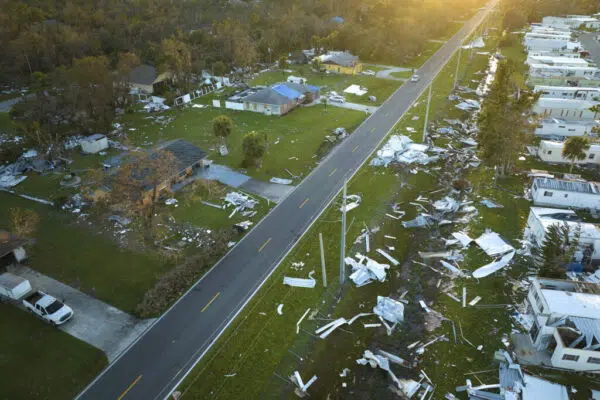
The repercussion of high impact weather goes beyond just humans; it affects ecosystems significantly too:
- Effects on biodiversity: Extreme weather events create unsuitable living conditions for some species; consequently disrupting their natural habitats which may lead them towards endangerment or extinction.
- Soil degradation and erosion: Severe rainfall and flooding lead to soil being washed away while landslides loosen up the ground’s composition – destabilizing buildings constructed upon it.
- Water pollution and scarcity: Contamination of freshwater occurs when floodwaters mix with industrial waste or other pollutants – affecting ecosystems along the way. Contrarily; periods of drought result in an overall shortage of clean water available for drinking purposes or agricultural needs.
- Damage to natural resources: High impact weather events pose a serious threat to forests, wetlands, and coastal areas that may take decades to recover – leading to far-reaching implications on the planet’s biodiversity.
Social Impacts
The detrimental effects of high impact weather on human lives can be felt throughout entire communities. High impact weather has the potential to reshape the fabric of our communities and devastate entire ecosystems.
- Loss of life and health complications: Extreme weather conditions can lead to tragic fatalities, illnesses, injuries, and trauma – leaving long-lasting effects on affected individuals.
- Mental health struggles: After experiencing severe natural disasters, people may develop symptoms of post-traumatic stress disorder (PTSD), depression, or anxiety due to loss of homes, livelihoods or loved ones.
- Population displacement: Forced migration is common in the aftermath of a calamitous meteorological event as it renders regions uninhabitable; this puts enormous pressure on countries receiving refugees as they must provide for their needs while facing potential social tensions among displaced populations.
- Strain on government services: High impact weather places a burden on already strained public systems like healthcare, education, and law enforcement agencies that must respond effectively during crises – often at the expense of neglecting other vital services.
Acknowledging these impacts highlights the importance of global efforts towards mitigating climate change-induced extreme events and formulating effective plans for preparedness before they occur – potentially reducing the severity and frequency with which we experience high impact weather altogether.
5 Examples of High Impact Weather and Their Impact on Businesses
For governments and emergency services, accurate weather data is crucial for disaster planning and response. High impact weather events can lead to emergencies such as floods and wildfires. With real-time and highly accurate weather data, these organizations can implement early warning systems, plan evacuations, and coordinate responses more effectively
- Hurricanes/Typhoons/Cyclones: These large-scale storm systems that can cause significant damage due to their powerful winds, heavy rains, and storm surge. Businesses can be directly affected through physical damage to buildings and infrastructure, disruption of supply chains due to closed ports or roads, and loss of productivity due to employee evacuations or inability to commute to work.
- Floods: Caused by heavy rainfall, rapid snowmelt, or dam breach, floods can lead to extensive water damage to business properties, loss of inventory, and disruption of operations. Infrastructure such as roads, bridges, and power lines can also be damaged, making it difficult for employees and customers to reach the business.
- Heatwaves: Periods of excessively hot weather can increase the demand for electricity due to air conditioning use, potentially causing power outages that disrupt business operations. For businesses that rely on outdoor work or have employees in non-air-conditioned environments, heatwaves can also pose significant health risks to workers, leading to decreased productivity or potential legal liabilities.
- Snowstorms/Blizzards: Heavy snowfall can cause travel disruptions, making it difficult for employees to get to work and for customers to reach businesses. For businesses that rely on shipping or delivery services, snowstorms can disrupt logistics and supply chains. Additionally, the weight of heavy snow can cause damage to buildings and infrastructure, leading to costly repairs.
- Droughts: Long periods of below-average precipitation can have significant impacts on businesses, especially those in the agricultural sector due to decreased crop yields. Water-intensive industries, such as manufacturing or power generation, may also face operational challenges due to water restrictions. Droughts can also lead to higher prices for water and electricity, increasing operational costs for all types of businesses.
5 Examples of High Impact Weather and Their Impact on Local Government
- Hurricanes/Typhoons/Cyclones: These powerful storms can cause significant damage to homes and other buildings, making them uninhabitable. They can also lead to power outages, making it difficult for people to communicate or access essential services. Additionally, the heavy rains can cause flooding, potentially leading to loss of life or injury. Residents may need to evacuate their homes, often on short notice, leading to significant disruption and stress.
- Floods: In urban areas, heavy rainfall can quickly overwhelm storm drainage systems, leading to flash floods. This can cause damage to homes and vehicles and can make roads impassable, disrupting transportation. In severe cases, people may need to be evacuated from their homes. Even after the floodwaters recede, there can be ongoing issues with mold, mildew, and water damage.
- Heatwaves: Excessive heat can pose significant health risks, particularly for the elderly, children, and those with underlying health conditions. Urban areas can experience even higher temperatures due to the “urban heat island” effect, where the concentration of buildings and pavement absorbs and re-radiates heat. This can lead to increased energy use for cooling, higher costs, and potential power outages.
- Snowstorms/Blizzards: Heavy snow and ice can make roads and sidewalks treacherous, leading to an increased risk of accidents. Public transportation may be delayed or canceled, making it difficult for people to get to work or school. Cold temperatures can also pose a risk of hypothermia, particularly for those without adequate heating.
- Wildfires: While wildfires are often associated with rural areas, they can also impact urban areas, particularly those near wildland interfaces. Smoke from wildfires can cause poor air quality, leading to respiratory issues. In extreme cases, residents may need to evacuate their homes due to approaching fires.
Having access to accurate, real-time weather data from Tomorrow.io empowers individuals, businesses, governements, and entire countries to anticipate these high impact weather events and take proactive measures to mitigate their impacts.
Tomorrow.io offers early warning systems designed to meet the unique needs of your business or government. Our cutting-edge platform providers hyperlocal weather alerts and insights tailored to your specific locations. Predictive insights guide your team to adjust operations schedules, implement emergency response plans, and take measures to protect infrastructure and inventory, protecting homes and buildings, planning for potential evacuations, and much more.
How Tomorrow.io Helps Businesses and Governments Combat High Impact Weather
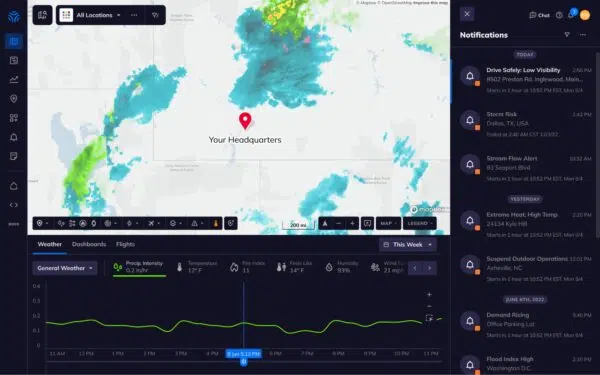
In order to combat increasingly volatile weather and the jump in high impact events, we must put better tools in place that can predict these events so that we are better prepared in our communities to combat them. The increased weather volatility has the potential to disrupt regular operations, pose safety hazards, and cost millions to correct.
Tomorrow.io’s weather and climate security software provides information to various sectors including aviation, construction, logistics and transportation, sports and events, and utility services.
Clients include high-profile companies like JetBlue, Shipt, and the New England Patriots. Tomorrow.io provides precise, timely weather data that empowers businesses and governments to better prepare for and navigate high impact weather events. Whether it’s airlines adjusting flight schedules or construction companies organizing operations around weather patterns, the ripple effect of accurate weather predictions cannot be understated.
What Preventative Measures and Risk Mitigation Exist for High Impact Weather
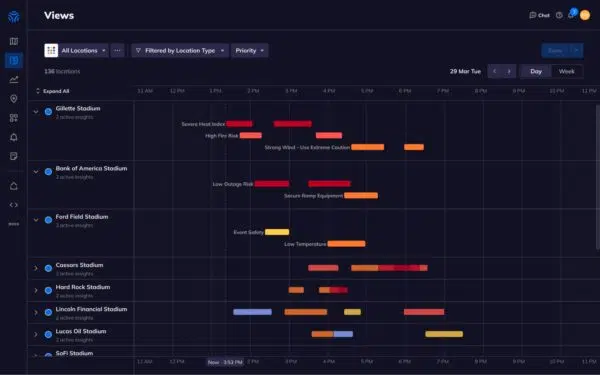
There are a slough of actions you can be taking to prepare for and mitigate the impact of high impact weather. And it’s not just severe weather that you can prepare for. From smaller high impact weather events such as short bouts of intense hail, dense fogs, or heavy smoke from wildfires, tools like weather intelligence from Tomorrow.io can help you be ready.
Preventative Measures
To better manage high impact weather events and mitigate their undesirable consequences, it is essential to adopt a multi-pronged approach involving early warning systems, structural solutions, and public education. By implementing these preventative measures, communities can be better prepared for severe weather conditions, reducing the detrimental effects on lives, infrastructure, and the economy.
Early Warning Systems
Early warning systems play a crucial role in forecasting meteorology phenomena and alerting individuals and authorities alike when extreme weather is impending. These systems rely on advanced satellite and ground-based radar technology that enables accurate predictions of high impact weather patterns as they develop. Some key components of effective early warning systems include:
- Meteorological data collection from various sources for analysis
- Accurate modeling of high impact weather events based on historical and real-time data
- Timely dissemination of warnings through appropriate communication channels (e.g., radio broadcasts, mobile phone alerts, and social media)
- Regular updates of advisories to keep the public informed about changes in the severity or path of an event
Tomorrow.io’s early warning system also directly supports the United Nations effort to ensure early warning for every person on Earth within five years. Tomorrow.io’s global early warning systems combine monitoring, forecasting, and alerting technologies with technical assistance and capacity building, and will soon be powered by global, near-real time data from the first commercial multi-sensor weather satellite constellation.
Our fully integrated sensing, modeling, and decision support tools deliver high-value weather and climate products for emergency response, agriculture, energy, health, and more. The success of early warning systems rests on their timely implementation, coupled with trustworthy information disseminated to the relevant stakeholders in easily understandable formats.
Structural Solutions
In addition to early warning systems, structural solutions can help minimize the damage caused by severe weather conditions. These measures involve improving infrastructure resilience against high impact weather events through strategic urban planning processes that take natural hazards into consideration. Common structural solutions include:
- Flood barriers, levees, or dams installed around floodplains or low-lying areas to protect groundwater sources from contamination during flooding episodes.
- Heat-resistant materials incorporated into building structures within areas prone to heatwaves.
- Earthquake-resistant designs implemented in seismically active regions vulnerable to tremors induced by thunderstorms or tropical cyclones.
- Robust stormwater management networks essential for mitigating increased flash flooding risks associated with climate change.
By addressing potential vulnerabilities in the built environment, structural solutions can help communities stand up to the challenges posed by high impact weather.
Public Education
Lastly, public education is an essential preventive measure against severe and hazardous weather events. Knowledge is a powerful tool that helps individuals assess potential risks and adopt appropriate actions to protect their families, homes, and local environments:
- Educating people on how to interpret early warning systems accurately allows them to make informed decisions about evacuations or securing their properties when required.
- Engaging communities in understanding the causes of meteorology phenomena increases awareness surrounding dangers such as lightning strikes during thunderstorms or storm surges in coastal areas.
- Disseminating practical instructions on emergency preparedness (e.g., assembling emergency kits, creating family plans) keeps populations proactive before extreme weather threats materialize.
Through this triad of preventative measures—early warning systems, structural solutions, and public education—communities worldwide can successfully brace themselves for future high impact weather-related challenges.
Mitigation Strategies
Mitigating the effects of high impact weather is crucial to saving lives, protecting property, and reducing economic losses. In this section, we will discuss two vital strategies that can help lessen the adverse consequences of severe weather events: advanced weather technology, emergency response plans, and insurance policies.
Predictive Weather Technology
Utilizing predictive weather technology like Tomorrow.io can be an essential part of a proactive mitigation strategy. Here’s how this advanced solution can aid in weather-related decision-making:
- Customized Early Warning Systems: Tomorrow.io offers finely-tuned early warning systems tailored to meet the unique needs of your business or government agency. With our cutting-edge technology, you receive hyperlocal weather alerts and insights specific to your operational locations.
- Operational Adjustments: These alerts can assist in proactively adjusting operation schedules, enabling businesses and governments to plan around impending weather events rather than simply reacting to them.
- Emergency Response Planning: Tomorrow.io’s system can aid in deploying emergency response plans at the right time, thereby helping to safeguard infrastructure and inventory, and potentially saving lives in the process.
- Strategic Evacuation Planning: Our technology can play a critical role in the planning for potential evacuations, enabling organizations to stay ahead of the weather and minimize its impact.
Want to Start Mitigating the Effects of High-Impact Weather Today? See Weather Intelligence
Emergency Response Plans and Early Warning Systems
Effective emergency response plans and early warning systems are essential in dealing with disastrous outcomes that high impact weather may bring. EWS are great preventative measures and mitigation strategies to combat the effects of high impact weather events. Governments or communities need to establish comprehensive plans that address various scenarios, ensuring that when disaster strikes, there is a well-coordinated system to provide aid and services. Key aspects of emergency response plans include:
- Risk Assessment: Identifying potential severe weather hazards in an area helps prioritize resources needed during an emergency.
- Alert Systems: Early warning systems notify the public about incoming extreme weather conditions so they can prepare accordingly.
- Evacuation Plans: Designated evacuation routes, shelters, and communication methods allow smooth transportation for residents trying to escape dangerous areas.
- Resource Allocation: Authorities should have provisions for distributing essential supplies such as food, water, and medical aid during emergencies.
- Coordination Among Agencies: Different governmental institutions must work together effectively to ensure a quick and comprehensive response.
By developing these strategies beforehand, responders can efficiently manage the aftermath of high impact meteorology events while minimizing damages resulting from them.
Insurance Policies
Insurance serves as a financial safety net for individuals, businesses, and governments during times of crisis caused by severe weather conditions. Several types of policies cater specifically to natural disasters; some common examples are:
- Homeowner’s Insurance: This policy typically covers damage due to high impact weather events like thunderstorms, hailstorms, or floods depending on the coverage purchased.
- Business Interruption Insurance: This policy safeguards businesses from lost revenue following extreme meteorological phenomena that force operations to cease temporarily.
- Crop Insurance: Farmers rely on protection from crop loss due to devastating storms or droughts brought by severe weather.
- Flood Insurance: As standard homeowner’s insurance often excludes flood coverage, specific policies protect property owners from damages related to flooding.
It is crucial for individuals and businesses living in areas prone to high impact weather to assess their risks carefully and select appropriate insurance coverage. By doing so, they can substantially reduce financial vulnerability during catastrophic events.
Both emergency response plans and insurance policies play pivotal roles in mitigating the effects of high-impact meteorology events. Establishing comprehensive plans that encompass an array of preventive measures while promoting public education on preparedness will go a long way in alleviating the consequences of extreme weather. At the same time, adopting suitable insurance policies as part of the risk management strategy can significantly lessen financial burdens during times of crisis.
Together, these approaches contribute immensely towards minimizing the damaging repercussions of severe weather conditions on communities across the globe.
What Does an Early Warning System for High Impact Weather look like?
At Tomorrow.io, we know the power of preparation. That’s why we’ve developed a robust early warning system, designed to keep you one step ahead of Mother Nature. Our early warning system is more than just a weather forecast. It’s a dynamic, real-time safeguard, tailored to empower businesses, governments, and individuals alike in the face of high impact weather events.
So, what exactly is an early warning system?
Imagine having the ability to peek into the future, to see potential disruptions and challenges on the horizon, and to prepare for them in advance. An early warning system does just that.
Tomorow.io’s EWS leverages state-of-the-art technology and vast amounts of data to predict high-impact weather events, providing essential lead time to plan, prepare, and mitigate risks. It’s like having your personal weather intelligence agent, working round-the-clock to keep you informed and safe.
An early warning system helps businesses prepare and improve operations around high impact weather events. Businesses like Shipt, Ford, and JetBlue are using Tomorrow.io’s weather intelligence platform for early warnings that provide insights on how to create operational efficiency when bad weather hits.
For local governments, “Our platform provides real-time data at a hyper-local level and provides decision-makers the tools to stay ahead of a storm. We also provide a much higher degree of accuracy leading into an event 24-48 in advance,” says Ed Carrol, Director of Government Sales at Tomorrow.io.
Tomorrow.io’s EWS is built on the backbone of our hyper-accurate, real-time weather forecasting capabilities. By integrating data from a myriad of sources, including our proprietary radar satellites, we create a comprehensive picture of future weather patterns, right down to the most local level. This enables us to provide advance warnings for a broad range of high impact weather events, from severe storms and flooding to heatwaves and wildfire smoke dispersion.
When we say ‘early’, we mean it. Our system can provide accurate alerts up to 14 days in advance, giving you ample time to make the right decisions. This could mean rerouting a delivery fleet ahead of a major storm, adjusting construction schedules due to expected heatwaves, or preparing city infrastructure for potential flooding.
An early warning system is more than a tool. It’s your partner in weather resilience, helping you navigate through the unpredictable world of weather.
How Tomorrow.io’s Satellite Constellation Will Change High Impact Weather
Space-based weather radar technology represents a game-changing leap in our ability to prepare for high impact weather events, and Tomorrow.io’s upcoming constellation is leading the way in this area.
One of the major limitations of traditional ground-based radar systems is their inability to cover vast oceanic areas and some remote regions. Approximately 70% of the Earth’s surface is covered by oceans, and these areas are often where major weather systems, such as hurricanes and typhoons, develop. Without precise, real-time data from these regions, our understanding and forecasting of these potentially devastating weather events can be limited.
To improve global forecasting capabilities, Tomorrow.io is launching a first-of-its-kind, commercial weather satellite constellation equipped with radars and microwave sounders. Space-based radar can detect precipitation with greater precision than traditional methods, providing more accurate data on rainfall intensity. Having already launched two satellites, R1 and R2, the eventual constellation will provide complete global coverage, including oceans and remote regions. This means we can monitor precipitation – a key factor in many high impact weather events – anywhere in the world, in real-time.
Conclusion
This guide has explored a wide range of topics related to the causes, consequences, and preparedness for various types of severe weather conditions. High impact weather can result from a myriad of factors such as climate change, geographic details, and even air pressure and wind patterns.
To effectively respond to these extreme weather events, it is crucial to have the most cutting-edge preventative measures in place. This includes employing early warning systems, investing in critical infrastructure improvements geared towards reducing vulnerabilities, and disseminating public education on safety precautions during severe weather incidents. And, most importantly, empowering your team with the tools they need to mitigate high-impact weather risks in advance of the event.
Tomorrow.io stands at the forefront of weather intelligence and climate adaptation platforms worldwide. Enhanced by state-of-the-art space technology, powerful AI, and our exclusive modeling abilities, our platform enables end-to-end high-impact weather mitigation. With innovative early warning systems and actionable insights, organizations can anticipate weather impacts, reduce risks, and boost operational resilience.
Ready to start adapting to high-impact weather?

